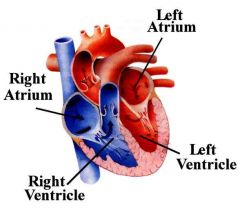![]()
![]()
![]()
Use LEFT and RIGHT arrow keys to navigate between flashcards;
Use UP and DOWN arrow keys to flip the card;
H to show hint;
A reads text to speech;
10 Cards in this Set
- Front
- Back
|
The Reflex Response |
A reflex is an automatic response by the nervous system to an external stimulus (ex. removing hand from hot stove).Sensory Receptor→Sensory Neuron→Interneuron (spinal cord ONLY)→Motor Neuron→Effector (Muscle/Gland)The message still goes to the brain but by the time you have “realized” the stove was hot, you have already removed your hand. |
|
|
The Brain |
CNS is made of the brain and the spinal cord. Brain is divided into three main sections: Cerebrum- controls thought, learning, and many other complex activities Cerebellum- regulates balance, posture, movement, and muscle coordination. Medulla- the lowest section of the brainstem (at the top end of the spinal cord); it controls automatic functions including heartbeat, breathing, swallowing, etc. |
|
|
Neurons |
Neurons- specialized cells that send and receive messages (electrochemical)Brain, spinal cord and nerves make up the nervous system. |
|
|
Dialysis Machine |
Dialysis machine filter blood artificially access kidney and cleans blood. |
|
|
Reflex Response Passage |
Sensory Receptor→Sensory Neuron→Interneuron (spinal cord ONLY)→Motor Neuron→Effector (Muscle/Gland) |
|
|
Gas Exchange Process |
The respiratory system draws oxygen-rich air into the lungs through a series of tube-like passages called bronchi. Bronchi are lined with tough connective tissue to keep the walls from collapsing. The bronchi branch into bronchioles that end in about 600 million tiny, air filled sacs called alveoli.lveoli are pressed up against capillary beds which contain blood. Since the air in the alveolus has a higher concentration of oxygen than the blood in the capillary, oxygen diffuses out of the alveolus and into the capillary. |
|
|
Digestive System Difficult Terms |
The food is pushed down the esophagus by contractions of muscle tissue. This is called peristalsis. The liver produces a substance called bile which is stored in the gall bladder. |
|
|
Pasteurization Definition |
Pasteurization- process of heating food to kill micro-organisms (milk is pasteurized) |
|
|
Label the right and left atrium, and ventricle |

|
|
|
What are neurons and nephrons? |
Neurons are a cell that send and receives messages. Nephrons are a filtering of waste and blood in the excretory system. |

